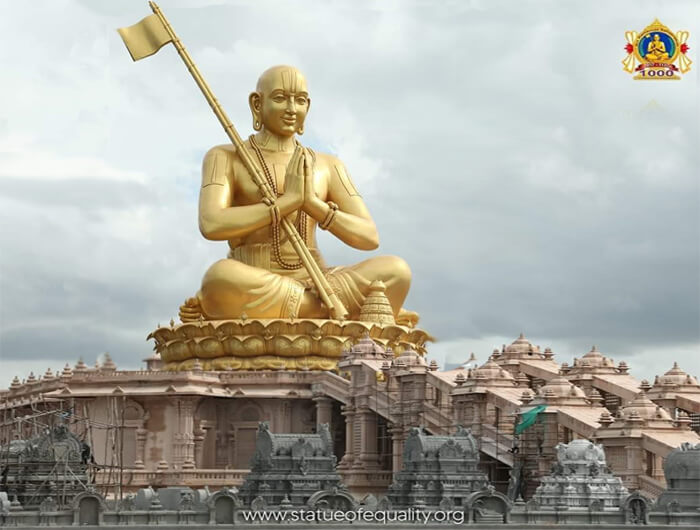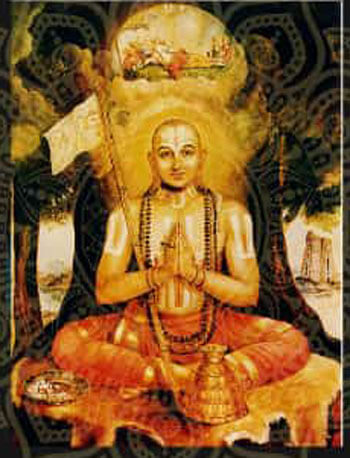Statue of Equality – Sri Ramanujacharya Statue

Statue of Equality is a 216 feet tall statue inaugurated in Hyderabad of Sri Ramanujacharya. He is an 11th-century Bhakti saint who promoted the idea of equality in all aspects of living. The statue is made of ‘Panch Loha’ which means 5 different metals are used to make it. These metals are iron, gold, silver, copper and bronze, and zinc. It is one of the world’s tallest statues in sitting posture. Until now the sitting statue of Buddha in Thailand was considered the tallest statue in sitting posture.
The statue is mounted on 54 feet high Bhadra altar. Inside the Bhadra Vedi, the floors are devoted to ancient documents related to the work of Saint Shri Ramanujacharya. There is a digital Library and Research Center too. There are 108 Divyadesh surrounding the Statue of Equality. In Hindu tradition Lord Vishnu has 108 incarnations and these Divyadesh are a symbol of them.
The Statue was inaugurated on the occasion of the 12-day Shri Ramanuja Millennium Celebrations, held to mark the 1000th birth anniversary of the great saint. The statue has been designed and conceived by Swami Chinna Jeyar of Sri Ramanujacharya Ashram. The statue, a tribute to the teachings of Sri Ramanujacharya, stands tall for India’s heritage. Its belief in treating everyone the same in quality, power, status, or degree, as was created by the almighty.
Sri Ramanujacharya (1017-1137 CE)

Sri Ramanujacharya is one of the great saints in India of the Hindu Bhakti Movement, he was an exponent of the Sri Vaishnavism tradition within Hinduism. He was born in 1017 AD according to astrological calculations, the sun was in the zodiacal sign of Cancer in a Brahmin family in Tamil Nadu. He worked for promoting the idea of equality in nationality, gender, caste, or creed.
His parents were Asuri Kesava and Kantimati, both from aristocratic families. Rumanja passed his childhood days in Sriperumbudur, the village of his birth. At the age of 16, he was married to Rakshakambal. At an early age, his father died and he became the head of the household and decided to move to Kanchi, a holy city famed for its scholars and magnificent temples.
He studied Vedas under one Yadavaprakasha, a teacher of Advaita philosophy. He was very intelligent since childhood and he used to remove the fault in the explanation of his Guru. Due to this his Guru got angry instead of being pleased with him. To take revenge the guru planned to kill him, but a hunter and his wife saved the life of Saint Ramanujacharya by the grace of god. He went to Kanchipuram and took the education of Vedanta.
Ramanuja knowledge of Vedanta increased so much in a short time that it became difficult for his guru Yadav Prakash to answer his arguments. The fame of Ramanuja’s scholarship continued to grow. The principle propounded by Ramanuja is called ‘Vishishtadvaita’. Ramanuja became a priest at the Varadharāja Perumal temple (Vishnu) at Kānchipuram, Tamil Nadu. Ramanuja was initiated into Sri Vaishnavism by Periya Nambi, also called Mahapurna, another Vedanta scholar.
He went to Tirumala and established a system and created a mutt (religious institution) to organize the activities of the Tirumala temple. Several ancient poets like Annamacharya, Bhakt Ramdas, Thyagaraja, Kabir, and Meerabai were inspired by him. In almost all of Sri Vaisnava Temples, Swami Ramanujacharyaji is given the foremost prominence.
His blessings are invoked at the beginning of all devotional services. He established the Vishistadvaita philosophy based on the Vedas and alwars’ Divya Prabandam. He appointed 74 simharihipathis to spread Sri Vaishnava sampradayam. He established a temple for SrimaN Narayana in a place called Thirunarayanapuram (called as Melkote) in Karnataka state near Mysore. His works continued and he took all efforts to spread Sri Sampradayam till his last.
The Sri Vaisnava tradition attributes nine Sanskrit texts to Ramanuja – Vedārthasangraha (literally, “Summary” of the “Vedas meaning”). Sri Bhāshya (a review and commentary on the Brahma Sutras), Bhagavad Gita Bhāshya (a review and commentary on the Bhagavad Gita), and the minor works titled Vedāntadipa. Vedāntasāra, Gadya Trayam (which is a compilation of three texts called the Saranāgati Gadyam, Sriranga Gadyam and the Srivaikunta Gadyam), and Nitya Grantham.
The Sattrumurai, or Appellations made to the Lord, at the end of daily services in a Sri Vaishnava Temple always conclude with the words:
Sarva Desa Dasa Kaleshu Parakrama
Ramanuja Arya Divyajna Vardhatam Abhivardhatam
Meaning: Let the most Magnificient instruction of Sri Ramanuja increase and pervade through all countries at all times,without any hindrance or impediment.
Suggested Read: Statue of Unity
